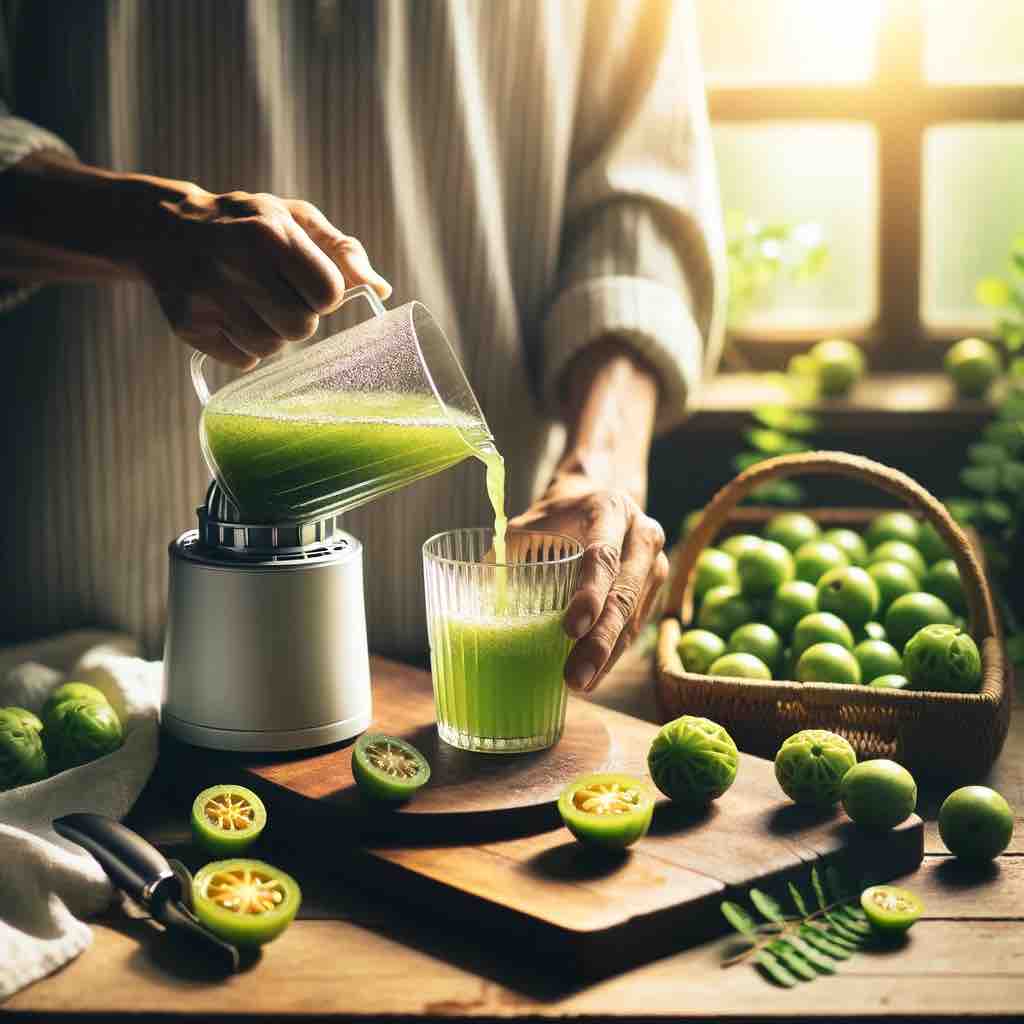
Welcome to a journey of taste and health, where we navigate the vibrant crossroads of Whole Fruits vs. Fruit Juice. In today’s health-conscious world, the choices we make in our diet are more than a matter of taste—they’re a commitment to our wellbeing.
As we embark on this exploration, let’s set one thing straight: This is not about the packaged, sugar-laden juices that crowd grocery store shelves. We’re diving into the world of fresh juice—the kind that sees fruits transform from solid to liquid right before your eyes. Whether it’s the charming sight of oranges being squeezed at a street stall or the comforting whirr of a blender in your kitchen, we’re talking about juice in its most natural and unadulterated form.
But here’s the twist: Is fresh juice always the healthier choice compared to eating whole fruits? It’s a question that often leaves even the most health-savvy individuals scratching their heads. In this deep dive, we’ll peel layer by layer, revealing not just the nutritional facts, but also the sensory joys of both whole fruits and fresh juice.
Why does this matter, you ask? Because in a world brimming with dietary advice and superfood trends, the simple act of choosing between a whole apple and a glass of freshly squeezed apple juice can be surprisingly complex. It’s about understanding the balance—between fiber and fructose, between convenience and nutrition, and ultimately, between various health benefits and potential drawbacks.
So, grab a fruit of your choice—be it crisp, leafy, or freshly juiced—and join us on this flavorful quest. We promise, by the end of this read, you’ll not only know when to choose which, but also how to make these choices work harmoniously with your lifestyle and health goals.
Let’s embark on this enlightening journey together, squeezing out wisdom from every fruit in sight!
[ez-toc]
Understanding Fresh Juice: Beyond the Surface Sweetness
As we venture into the juicy details, it’s crucial to understand what we mean by fresh juice. This isn’t your average, run-of-the-mill juice carton picked up from a grocery aisle. We’re talking about juice in its purest form – squeezed or extracted directly from fresh fruits, without the intrusion of added sugars, preservatives, or artificial flavors.
Why Fresh Juice? The allure of fresh juice is undeniable. It’s the quintessential summer refreshment – a burst of flavor and a testament to simplicity. Picture a hot summer day, a street corner with a fruit stand, where oranges, lemons, and pomegranates are turned into glasses of vibrant, thirst-quenching elixirs. Or imagine starting your day with a glass of juice, made from fruits handpicked from your garden or local market – it’s nature’s own energy drink.
But here’s the catch: While fresh juice packs a punch in terms of taste and instant energy, it’s not without its drawbacks. When fruits are juiced, a significant part of their goodness – the fiber – is left behind. This fiber is not just a filler; it’s a key player in regulating digestion, maintaining blood sugar levels, and keeping you feeling full longer.
In the following sections, we’ll delve deeper into these aspects. We’ll explore how fresh juice compares to whole fruits in terms of nutritional value, health impact, and practicality in everyday life. Whether you’re a fitness enthusiast, a busy professional, or someone juggling multiple roles, understanding these nuances will help you make choices that align with your health goals and lifestyle needs.
So, let’s squeeze out the facts and pulp the myths surrounding fresh juice – it’s time to find out if the juice is really worth the squeeze!
The Whole Truth About Whole Fruits: Nature’s Nutritional Powerhouses
Now, let’s turn our attention to the protagonists of our story: whole fruits. These natural wonders are not just food; they’re nutritional symphonies, each note playing a crucial role in our health.
Fiber: The Unsung Hero in Whole Fruits
One of the most compelling reasons to reach for whole fruits is their fiber content. Unlike fresh juice, whole fruits retain all their dietary fiber – both soluble and insoluble. This fiber is a boon for our digestive health, aiding in everything from smoothing digestion to regulating blood sugar levels and lowering cholesterol. Moreover, fiber contributes to a feeling of fullness, which can be a great ally in weight management.
Vitamins, Minerals, and Antioxidants Galore
Whole fruits are also packed with a variety of vitamins, minerals, and antioxidants. These nutrients are integral to our body’s daily functions – from boosting immunity to fighting inflammation and slowing down the aging process. The natural sugars in whole fruits, bound within their fibrous matrix, are released slowly into the bloodstream, offering a balanced energy source without the sharp spikes in blood sugar that juices might cause.
The Sensory and Emotional Experience
Let’s not forget the sensory experience of eating whole fruits – the crunch of an apple, the juiciness of a ripe peach, or the tang of a fresh berry. Eating whole fruits is not just about nutrition; it’s an emotional and sensory journey – a connection to the food that nourishes our bodies and souls.
In the next sections, we’ll juxtapose these benefits with those of fresh juice. We’ll look at how each fits into different lifestyles and dietary needs, and how you can make the most of both in your daily diet.
Comparing Apples to Apples: Whole Fruits vs. Fresh Juice in the Nutritional Spotlight
As we weave through the orchard of facts, it’s time to place whole fruits and fresh juice side by side under the nutritional microscope. This comparison isn’t just about counting calories or measuring sugar levels; it’s about understanding how each choice fits into the complex puzzle of overall wellness.
The Nutritional Trade-Offs of Fresh Juice
When fruits are juiced, their fibrous structure is broken down, and what you get is a concentration of their flavors and nutrients – but with a caveat. The absence of fiber in fresh juice means that the natural sugars are absorbed more rapidly into your bloodstream. This can lead to quicker spikes in blood sugar levels – a point of concern, especially for those managing conditions like diabetes.
However, it’s not all about what’s lost. Fresh juice still retains most of the vitamins, minerals, and antioxidants found in whole fruits. For individuals who struggle with solid food, have digestive issues, or need a quick nutrient boost, a glass of fresh juice can be a valuable addition to their diet.
Whole Fruits: The Complete Package
In contrast, whole fruits offer the full spectrum of nutrition as nature intended. The fiber in whole fruits not only slows down sugar absorption but also adds to gut health and satiety. This makes whole fruits a more balanced option, especially for those looking to manage weight or blood sugar levels.
Moreover, the act of eating whole fruits – chewing and digesting them – also plays a role in how our body and mind perceive satiety. The physical act of eating and the time it takes can make us feel fuller and more satisfied.
The Context Matters: Lifestyle and Health Goals
Choosing between whole fruits and fresh juice isn’t a one-size-fits-all decision. It’s about context. For a busy professional needing a quick morning boost, a glass of fresh juice might make more sense. For someone focusing on weight management or blood sugar control, whole fruits could be the way to go.
In our next section, we’ll dive into practical scenarios, offering tips on how to harmoniously incorporate both whole fruits and fresh juice into your diet, tailored to your unique lifestyle and health objectives.
Practical Scenarios: Balancing Whole Fruits and Fresh Juice in Your Diet
In the intricate dance of nutrition, knowing when and how to include whole fruits and fresh juice can significantly impact your health and enjoyment. Let’s explore some practical scenarios to guide you in making these choices seamlessly fit into your daily routine.
1. The Quick Morning Rush
For those mornings when time is a luxury, a glass of fresh juice can be a lifesaver. It’s a swift way to consume essential nutrients. However, to avoid rapid sugar spikes, consider juices with more vegetables than fruits, or add a source of protein like a handful of nuts to balance it out.
2. Post-Workout Replenishment
After a strenuous workout, your body needs quick replenishment. While whole fruits can be beneficial, a glass of fresh juice can provide a faster way to hydrate and deliver vital nutrients to your muscles. Consider a blend of fruits with a dash of greens for an added nutritional punch.
3. Managing Weight and Blood Sugar Levels
If weight management or blood sugar control is your goal, whole fruits are your allies. Their fiber content helps regulate sugar absorption and promotes a feeling of fullness. Snack on whole fruits like apples or berries throughout the day for a healthy, filling treat.
4. Digestive Health and Ease
For individuals with digestive challenges, fresh juice can be gentler on the stomach, providing nutrition without the bulk of fiber. However, it’s important not to eliminate fiber from your diet, as it’s crucial for gut health.
5. Children and Picky Eaters
Getting children or picky eaters to consume enough fruits can be a challenge. Fresh juice can be a fun and easy way to introduce them to a variety of fruits. However, encourage whole fruits as well to develop healthy eating habits.
6. Flavor and Variety
Both whole fruits and fresh juice offer a spectrum of flavors and experiences. Experiment with different fruits and combinations to keep your palate excited and your nutrition varied.
Moving forward, let’s focus on specific fruits and their unique benefits whether consumed whole or as fresh juice.
Spotlight on Specific Fruits: Whole vs. Juiced
Each fruit brings its own set of nutritional benefits, whether enjoyed in its whole form or as fresh juice. Here, we’ll spotlight some popular fruits and explore how their benefits vary in different forms, helping you make informed choices based on your preferences and health goals.
1. Apples: Fiber-Rich vs. Antioxidant-Packed
Whole: Eating an apple with its skin provides dietary fiber, which aids in digestion and helps regulate blood sugar levels.
Juiced: Apple juice is rich in antioxidants and vitamins but lacks fiber. It’s a good quick energy source but should be consumed in moderation due to its sugar content.
2. Oranges: Vitamin Powerhouse vs. Refreshing Hydration
Whole: Oranges are high in vitamin C and fiber, which are crucial for immune health and digestion.
Juiced: Freshly squeezed orange juice retains vitamin C but loses fiber. It’s a refreshing choice for hydration but can lead to quicker sugar absorption.
3. Berries: Antioxidant-rich vs. Nutrient-dense Juice
Whole: Berries are loaded with antioxidants, vitamins, and fiber, making them excellent for heart health and blood sugar control.
Juiced: Berry juice is a concentrated source of vitamins and antioxidants but should be combined with other fruits or vegetables to balance sugar content.
4. Grapes: Heart Health vs. Resveratrol Boost
Whole: Whole grapes are beneficial for heart health and contain fiber for digestive wellness.
Juiced: Grape juice contains resveratrol, known for its heart health benefits, but lacks the fiber found in whole grapes.
5. Carrots: Crunchy Nutrient Store vs. Vision-Boosting Drink
Whole: Eating carrots provides dietary fiber and the full spectrum of their vitamins.
Juiced: Carrot juice is a great source of beta-carotene, essential for eye health, but lacks the fiber of whole carrots.
Health Considerations: Diabetes and Blood Sugar Management
In the kaleidoscope of dietary choices, understanding the impact of what we consume on our blood sugar levels is crucial, particularly for individuals managing diabetes. The decision between reaching for whole fruits or a glass of fresh juice takes on additional significance in this context.
Whole Fruits: A Natural Ally in Blood Sugar Regulation
Whole fruits, with their intact fiber, play a pivotal role in blood sugar management. The fiber found in fruits like apples, pears, and berries slows down the absorption of sugar into the bloodstream, preventing rapid spikes in blood glucose levels. This gradual release is especially beneficial for those with diabetes, as it aids in maintaining steady blood sugar levels. Moreover, the fiber contributes to prolonged satiety, which can help in curbing unhealthy snacking habits that might disrupt glycemic control.
Fresh Juice: A Delicate Balance
Fresh juice, while a rich source of vitamins and antioxidants, presents a different scenario. Without the fibrous matrix of whole fruits, the natural sugars in juice are absorbed more quickly, potentially leading to sudden increases in blood sugar. This doesn’t mean fresh juice is off-limits for those with diabetes or prediabetes. However, it calls for mindful consumption. Opting for juices that are lower in natural sugars, such as those made from vegetables or incorporating a mix of vegetables and fruits, can be a healthier choice. Additionally, consuming fresh juice along with a source of protein or healthy fat can help mitigate rapid sugar absorption.
Practical Tips for Blood Sugar Management
- Choose Low Glycemic Fruits: Opt for fruits like berries, cherries, and apples, which have a lower glycemic index.
- Mind the Portion: Keep juice portions small. A half-cup (4 ounces) is often sufficient.
- Timing Matters: Consume fresh juice with a meal rather than on its own to help slow down the absorption of sugars.
- Test and Learn: Monitor blood sugar levels to understand how your body responds to different fruits and juices.
In summary, while whole fruits are generally a safer bet for blood sugar management, fresh juice can still be part of a diabetes-friendly diet when chosen wisely and consumed in moderation.
Pregnancy and Nutritional Needs
Pregnancy is a time of heightened nutritional awareness, where the choices made by expectant mothers can have a significant impact on both their health and the health of their baby. Let’s examine how whole fruits and fresh juice can be optimally included in a prenatal diet.
Whole Fruits: Vital Nutrients for Mother and Baby
During pregnancy, whole fruits are a treasure trove of essential nutrients. Fruits like bananas, avocados, and berries are packed with vitamins, fiber, and minerals crucial for the healthy development of the baby. For instance, the folic acid found in oranges and strawberries is vital for fetal development, while the potassium in bananas can help alleviate pregnancy-related leg cramps. The fiber in whole fruits is equally important, aiding in digestion and reducing the risk of constipation, a common concern during pregnancy.
Fresh Juice: A Cautionary Tale of Moderation and Variety
Fresh juice can be a delightful and refreshing way to consume nutrients, but it requires a bit more caution during pregnancy. The lack of fiber and the concentration of sugars mean that fresh juices should be consumed in moderation. Additionally, ensuring that the juice is freshly prepared and consumed immediately is crucial to avoid any risk of bacterial contamination, which can be harmful during pregnancy. Vegetable-based juices or those diluted with water can be a healthier option, providing hydration and nutrients without excessive sugar.
Guidelines for Healthy Consumption During Pregnancy
- Diversify Your Fruit Intake: Aim for a colorful variety of fruits to ensure a range of nutrients.
- Hygiene is Paramount: Ensure all fruits and preparation surfaces are clean to avoid the risk of contamination.
- Balance is Key: Include both whole fruits and fresh juice in moderation as part of a balanced diet.
- Listen to Your Body: Pay attention to how your body reacts to different fruits and juices, and adjust your diet accordingly.
Remember, while fruits and juices are beneficial, they are just one part of a comprehensive prenatal nutrition plan. Consulting with a healthcare provider for personalized dietary advice is always recommended.
Weight Management and Dietary Balance
In the quest for weight management and a balanced diet, understanding how to effectively incorporate whole fruits and fresh juice is key. Each has its place in a healthy diet, but their roles can differ significantly, especially when it comes to weight management.
Whole Fruits: A Weight Management Ally
For those aiming to manage or reduce their weight, whole fruits are invaluable allies. The fiber in fruits like apples, pears, and berries not only helps in feeling fuller for longer but also aids in controlling cravings and reducing overall calorie intake. This fiber also ensures a slow and steady release of sugars, providing a consistent energy supply without the risk of sugar highs and lows that can lead to overeating.
Fresh Juice: Mindful Enjoyment Is Essential
While fresh juice provides a concentrated dose of vitamins and nutrients, its lack of fiber and higher sugar concentration compared to whole fruits means it should be consumed with caution in a weight-conscious diet. Enjoying a small glass of fresh juice can indeed be part of a balanced diet, but it’s important to be mindful of portion sizes and the potential for calorie accumulation, especially from sweeter fruits.
Strategies for Incorporating Fruits and Juice in a Balanced Diet
- Choose Whole Fruits for Snacks: Opt for whole fruits as snacks instead of other high-calorie options.
- Be Mindful of Juice Portions: Limit juice portions to small servings and consider diluting with water.
- Incorporate Vegetable Juices: Choose juices made primarily from vegetables, which are typically lower in calories and sugars.
- Balance Your Meals: Ensure each meal is balanced with proteins, healthy fats, and carbohydrates alongside fruits or fruit juices.
Remember, the goal is to enjoy the benefits of fruits and juices without compromising your dietary goals. It’s all about balance, portion control, and making choices that align with your individual health needs.
Conclusion: Nourishing Choices for a Healthier You
As we wrap up our exploration of “Whole Fruits vs. Fruit Juice: When to Choose Which,” it’s clear that both whole fruits and fresh juice hold valuable places in our diets. The key lies in making informed, mindful choices that align with our individual health goals, nutritional needs, and personal preferences.
Empowering Your Dietary Journey
- Embrace whole fruits as daily staples for their fiber, vitamins, and minerals, which are essential for overall health, digestion, and satiety.
- Enjoy fresh juice in moderation, particularly if you’re managing weight or blood sugar levels. Remember, fresh juice can be a nutrient-rich addition to your diet, but it’s not a complete substitute for the comprehensive benefits of whole fruits.
Tailoring Choices to Your Lifestyle
- Whether it’s a quick morning refreshment, a post-workout boost, or a mindful snack, choose between whole fruits and fresh juice based on your daily activities and health objectives.
- For those with specific dietary needs, like diabetes or pregnancy, prioritize choices that best support your health and consult with healthcare professionals for personalized advice.
A Call for Varied and Balanced Nutrition
- Strive for a varied and colorful diet. Incorporating a wide range of fruits, in both whole and juiced forms, ensures a broader spectrum of nutrients and flavors.
- Remember, the journey to optimal health is not just about what you eat and drink, but how you do it. Mindfulness in consumption, portion control, and enjoying the process are all part of a healthy relationship with food.
As you move forward, let the knowledge and insights from this exploration guide you in making nourishing choices. Whether you’re savoring the crunch of an apple or enjoying a glass of freshly squeezed juice, each decision is a step towards a healthier, more vibrant you.
Thank you for joining us on this journey. Here’s to making choices that are not only delicious but also deeply nourishing!













